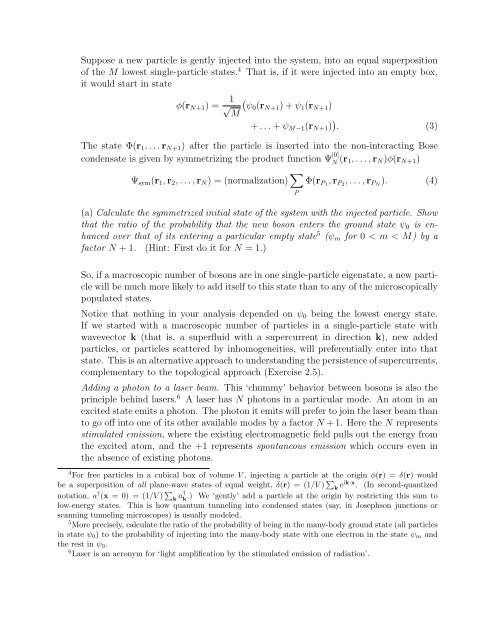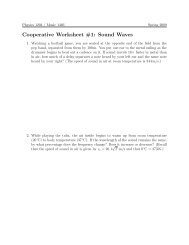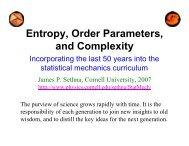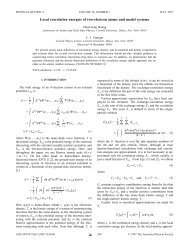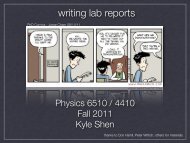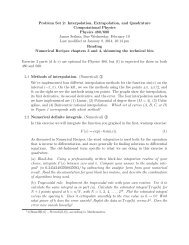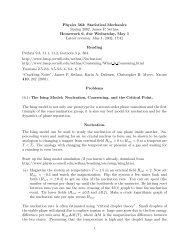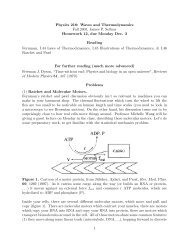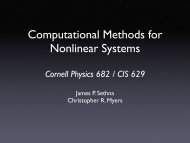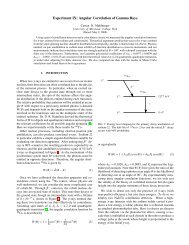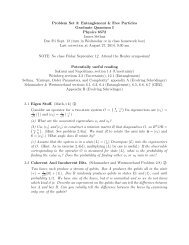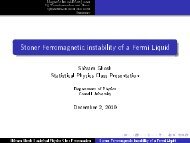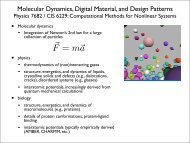4. Bosons, Fermions, and Anyons - Are you sure you want to look at ...
4. Bosons, Fermions, and Anyons - Are you sure you want to look at ...
4. Bosons, Fermions, and Anyons - Are you sure you want to look at ...
You also want an ePaper? Increase the reach of your titles
YUMPU automatically turns print PDFs into web optimized ePapers that Google loves.
Suppose a new particle is gently injected in<strong>to</strong> the system, in<strong>to</strong> an equal superpositionof the M lowest single-particle st<strong>at</strong>es. 4 Th<strong>at</strong> is, if it were injected in<strong>to</strong> an empty box,it would start in st<strong>at</strong>eφ(r N+1 ) = 1 √M(ψ0 (r N+1 ) + ψ 1 (r N+1 )+ . . . + ψ M−1 (r N+1 ) ) . (3)The st<strong>at</strong>e Φ(r 1 , . . . r N+1 ) after the particle is inserted in<strong>to</strong> the non-interacting Bosecondens<strong>at</strong>e is given by symmetrizing the product function Ψ [0]N (r 1, . . . , r N )φ(r N+1 )Ψ sym (r 1 , r 2 , . . . , r N ) = (normaliz<strong>at</strong>ion) ∑ PΦ(r P1 , r P2 , . . . , r PN ). (4)(a) Calcul<strong>at</strong>e the symmetrized initial st<strong>at</strong>e of the system with the injected particle. Showth<strong>at</strong> the r<strong>at</strong>io of the probability th<strong>at</strong> the new boson enters the ground st<strong>at</strong>e ψ 0 is enhancedover th<strong>at</strong> of its entering a particular empty st<strong>at</strong>e 5 (ψ m for 0 < m < M) by afac<strong>to</strong>r N + 1. (Hint: First do it for N = 1.)So, if a macroscopic number of bosons are in one single-particle eigenst<strong>at</strong>e, a new particlewill be much more likely <strong>to</strong> add itself <strong>to</strong> this st<strong>at</strong>e than <strong>to</strong> any of the microscopicallypopul<strong>at</strong>ed st<strong>at</strong>es.Notice th<strong>at</strong> nothing in <strong>you</strong>r analysis depended on ψ 0 being the lowest energy st<strong>at</strong>e.If we started with a macroscopic number of particles in a single-particle st<strong>at</strong>e withwavevec<strong>to</strong>r k (th<strong>at</strong> is, a superfluid with a supercurrent in direction k), new addedparticles, or particles sc<strong>at</strong>tered by inhomogeneities, will preferentially enter in<strong>to</strong> th<strong>at</strong>st<strong>at</strong>e. This is an altern<strong>at</strong>ive approach <strong>to</strong> underst<strong>and</strong>ing the persistence of supercurrents,complementary <strong>to</strong> the <strong>to</strong>pological approach (Exercise 2.5).Adding a pho<strong>to</strong>n <strong>to</strong> a laser beam. This ‘chummy’ behavior between bosons is also theprinciple behind lasers. 6 A laser has N pho<strong>to</strong>ns in a particular mode. An a<strong>to</strong>m in anexcited st<strong>at</strong>e emits a pho<strong>to</strong>n. The pho<strong>to</strong>n it emits will prefer <strong>to</strong> join the laser beam than<strong>to</strong> go off in<strong>to</strong> one of its other available modes by a fac<strong>to</strong>r N + 1. Here the N representsstimul<strong>at</strong>ed emission, where the existing electromagnetic field pulls out the energy fromthe excited a<strong>to</strong>m, <strong>and</strong> the +1 represents spontaneous emission which occurs even inthe absence of existing pho<strong>to</strong>ns.4 For free particles in a cubical box of volume V , injecting a particle <strong>at</strong> the origin φ(r) = δ(r) wouldbe a superposition of all plane-wave st<strong>at</strong>es of equal weight, δ(r) = (1/V ) ∑ k eik·x . (In second-quantizednot<strong>at</strong>ion, a † (x = 0) = (1/V ) ∑ k a† k.) We ‘gently’ add a particle <strong>at</strong> the origin by restricting this sum <strong>to</strong>low-energy st<strong>at</strong>es. This is how quantum tunneling in<strong>to</strong> condensed st<strong>at</strong>es (say, in Josephson junctions orscanning tunneling microscopes) is usually modeled.5 More precisely, calcul<strong>at</strong>e the r<strong>at</strong>io of the probability of being in the many-body ground st<strong>at</strong>e (all particlesin st<strong>at</strong>e ψ 0 ) <strong>to</strong> the probability of injecting in<strong>to</strong> the many-body st<strong>at</strong>e with one electron in the st<strong>at</strong>e ψ m <strong>and</strong>the rest in ψ 0 .6 Laser is an acronym for ‘light amplific<strong>at</strong>ion by the stimul<strong>at</strong>ed emission of radi<strong>at</strong>ion’.


